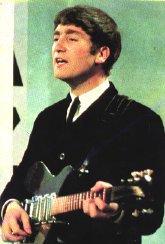| When I Get Home
What's the New Mary Jane
Fun is the One Thing that Money Can't Buy
Beatle Links
John Lennon
Paul McCartney
George Harrison
Ringo Starr
My Writings
Beatles Catalog
|
|
Biography
John Winston Lennon was born on October 9, 1940 in Liverpool. In the mid-1950s, he created a skiffle group called the Quarrymen. On July 6, 1957 he met Paul McCartney, who later joined the group that later became the Beatles. He married Cynthia Powell in 1962, and the following year, their son Julian was born. The acknowledged "leader" of the group wrote two books of poetry and prose, In His Own Write and A Spaniard in the Works.
In late 1966, he met artist Yoko Ono. He devoted most of his attention to her, definitely somewhat leading to the break-up of the Beatles in 1970 (though he left September 11, 1969). He released semi-sucessful solo albums until 1975, when son Sean was born, who John devoted all his time to. In 1980, he and Yoko recorded a comeback, Double Fantasy. The album was both triumphant and tragic.
The album was a hit, but on December 8, 1980 John was shot to death.
We miss you John.
|
 JOHN LENNON: 1940-1980
Although I never met you, you're one of my closest friends.
JOHN LENNON: 1940-1980
Although I never met you, you're one of my closest friends. |
|
Please post your tributes to John on our discussion forum.
|
|
"Imagine"
John's most famous solo song is this masterpiece, a call for uniting the world. The album of the same name reached #1 on the charts, while the single managed to get to #2. John's first #1 single came in 1974, with "Whatever Gets You Thru the Night."
Non-Beatles/ Music Work
In 1967, John was in the movie How I Won the War. He later appeared in several more films, including a few avant-garde creations by Yoko and him.
|
John at Press Conferences
"All our songs are anti-war."
"Oh, we like the Beatles. They're gear."
[on fan mail] "We're going to answer every one of them."
Reporter: Do you have any special advice for teenagers?
John: Don't get pimples.
|
Listen to this
The Walls and Bridges album had a popular series of promotions called 'Listen to This!' which included buttons (shown above), radio spots, and more. |
|

